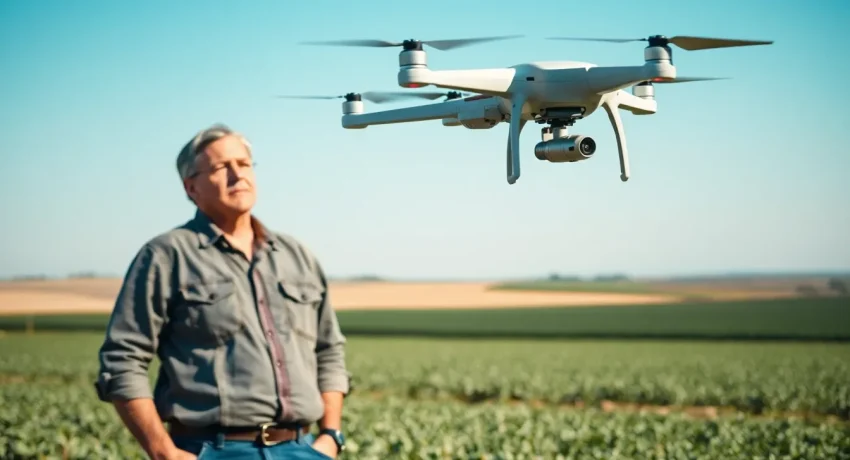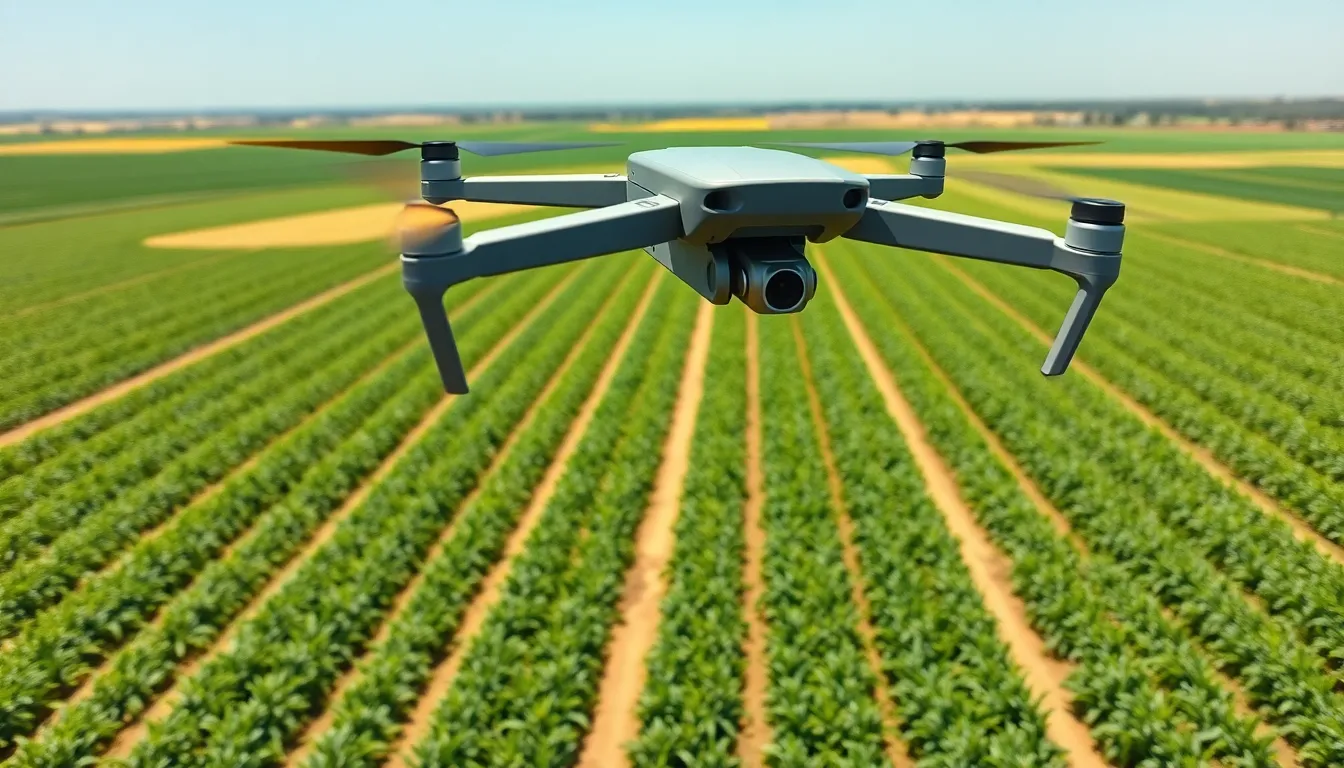Table of Contents
ToggleIn a world where drones are no longer just for spying on your neighbor’s cat, drone technology news is buzzing with excitement. These flying marvels are transforming industries from agriculture to entertainment, and they’re doing it with style. Imagine a future where your pizza arrives via drone, or farmers use swarms of them to monitor crops. Sounds like science fiction? Think again!
As drone technology continues to evolve at breakneck speed, staying updated is crucial. Whether it’s the latest in drone delivery systems or groundbreaking innovations in aerial photography, there’s always something new on the horizon. So buckle up and prepare for takeoff—this is the place to catch all the latest buzz in the drone world. After all, who wouldn’t want to stay ahead of the curve while having a little fun along the way?
Overview of Drone Technology News
Drone technology is evolving rapidly, with significant news impacting various sectors. Recent innovations include enhanced battery life, enabling longer flight for various applications. Many companies now focus on developing autonomous delivery drones, which promise to revolutionize logistics.
Significant regulatory changes are occurring, allowing more extensive use of drones in urban settings. The Federal Aviation Administration (FAA) continues to update regulations to accommodate these advancements, ensuring safety as drone usage expands. Companies like Amazon and Google are expanding their delivery services, aiming to launch commercial drone operations in more regions.
Technological enhancements in UAV (unmanned aerial vehicle) capabilities drive interest in aerial photography. Improvements in camera quality and stabilization technologies have captured the attention of the film industry. Professional videographers increasingly incorporate drones into their workflows, creating stunning aerial shots previously challenging to obtain.
Agriculture also benefits from drone innovations. Businesses utilize drones for crop monitoring, offering efficient solutions like real-time data collection. Farmers gain insights into soil health and crop conditions, enabling informed decision-making.
Furthermore, environmental monitoring efforts leverage drone technology. Researchers deploy drones for wildlife surveys and habitat assessments, providing crucial data needed for conservation. Applications in disaster management include aerial surveys, enabling quick assessments of damage after natural calamities.
Staying updated with developments in drone technology fosters awareness of its vast potential. Engaging with recent news helps readers understand how these advancements can impact their work, communities, and lives. The future promises even more exciting innovations in drone applications across sectors.
Recent Advances in Drone Technology
Recent advancements in drone technology are reshaping multiple industries. Innovations and applications showcase the significant potential drones offer.
Innovations in Drone Design
New materials enhance drone durability and reduce weight. Manufacturers focus on aerodynamic shapes to improve flight efficiency. Battery technology advances allow for longer flight times, enhancing operational capabilities. Some designs feature foldable components, making drones more portable. Enhanced sensors increase accuracy in navigation and obstacle detection, elevating safety standards. Companies continually invest in research and development to push drone design boundaries.
Cutting-Edge Applications
Drones find various uses across diverse fields. In agriculture, drones survey fields, providing real-time insights on crop health. Emergency services deploy drones for rapid assessments in disaster situations, facilitating quicker responses. Filmmakers utilize drones equipped with high-resolution cameras to capture stunning aerial footage. Package delivery services thrive with drones optimizing logistics and reducing delivery times. Environmental organizations use drones to monitor wildlife and assess ecological conditions, supporting conservation efforts. These applications illustrate the breadth of capabilities drones can offer.
Regulatory Changes Affecting Drones
Regulatory changes are significantly shaping the landscape of drone technology and its applications. Recent modifications led by the Federal Aviation Administration (FAA) aim to streamline drone usage, especially in urban areas.
Government Policies and Drone Use
Policies aimed at expanding drone operations are currently unfolding. The FAA has initiated a framework allowing commercial drone deliveries to take place in more locations. Increased collaboration between the government and private companies, like Amazon and Google, also supports this growth by establishing regulations that prioritize safety and efficiency. New rules focus on pilot training and operational limits, ensuring responsible use of drones while also promoting innovation in delivery services and other industries.
International Regulations and Compliance
Compliance with international regulations is crucial for global drone operations. Various countries have established unique rules to govern drone flights, creating a complex landscape for manufacturers and operators. The International Civil Aviation Organization (ICAO) sets guidelines that many nations adopt, focusing on safety and airspace management. Some regulations emphasize data protection, particularly concerning aerial surveillance. Adhering to these international standards helps companies avoid legal issues and fosters smoother cross-border drone operations while enhancing safety protocols worldwide.
Impact of Drone Technology on Various Industries
Drone technology significantly transforms multiple sectors. Its applications range from agriculture to logistics, showcasing innovative solutions and enhancing operational efficiency.
Agriculture and Crop Management
Drones play a pivotal role in agriculture and crop management. Farmers use these aerial devices for monitoring crop health, assessing soil conditions, and optimizing irrigation practices. Enhanced data collection offers real-time insights, allowing for timely interventions. Visualize drone surveys alongside traditional methods; the former saves time and provides a broader perspective. Fertility mapping and pest detection benefit from drone imagery, reducing reliance on pesticides and improving yield quality. With continued technological improvements, these aerial tools support sustainable farming practices.
Delivery and Logistics Solutions
Logistics benefits immensely from drone technology. Companies like Amazon employ drones for quick and efficient package deliveries. Enhanced battery life and autonomous systems speed up operations, creating a more effective supply chain. Urban areas find new opportunities with drone-based delivery, cutting down on traffic congestion and carbon emissions. Businesses capitalize on real-time tracking, ensuring customers receive their orders promptly. As regulations evolve, broader adoption of drone logistics is expected, fundamentals reshaping traditional delivery methods.
Future Trends in Drone Technology
Innovations in drone technology continue to push boundaries, leading to increased efficiency and capability across multiple sectors. Autonomous flying is gaining traction; UAVs are expected to navigate urban environments without human intervention. Intelligent algorithms enhance decision-making, allowing drones to operate safely even in complex conditions.
The logistics industry is on the verge of transformation. Companies like Amazon and Google are expanding their delivery networks while integrating autonomous drones, promising faster package delivery times. Studies suggest that package delivery via drones can reduce traffic congestion, especially in crowded cities.
Advancements in battery technology are making longer flight times feasible. Current developments indicate a shift toward energy-dense batteries, which extend the operational range of drones significantly. These enhancements support more extensive applications, including emergency response and surveillance.
Environmental monitoring is another area poised for growth. Drones equipped with advanced sensors are already collecting invaluable data on wildlife and climate change. It’s reported that deploying drones for ecological assessments can lead to more effective conservation strategies.
A push towards regulatory clarity accelerates drone integration into everyday life. The FAA is establishing frameworks to govern urban drone operations, making compliance more straightforward for companies. Stakeholders emphasize the importance of cooperation between regulators and the private sector to ensure safe drone usage.
Improved aerial photography capabilities are attracting filmmakers and marketers alike. Enhanced cameras combined with stabilization technology provide stunning visuals, creating new opportunities for creative storytelling. Filmmakers are increasingly using drones to capture breathtaking shots, revolutionizing the film industry.
Drones also contribute significantly to agriculture by facilitating precision farming. They enable real-time crop monitoring, equipping farmers with vital data for decision-making. Many experts agree that these data-driven insights are vital for improving yields and sustainability.
Conclusion
The landscape of drone technology is evolving at an unprecedented pace. As industries increasingly adopt these innovations the potential for efficiency and sustainability grows. Enhanced capabilities in logistics agriculture and environmental monitoring highlight the versatility of drones.
With ongoing regulatory support and advancements in design and functionality the future of drone applications looks promising. Businesses and consumers alike can expect more seamless integration of drones into daily life. Staying updated on these developments will be crucial for anyone interested in the transformative power of drone technology. The journey ahead is filled with opportunities that could reshape how we interact with the world.





